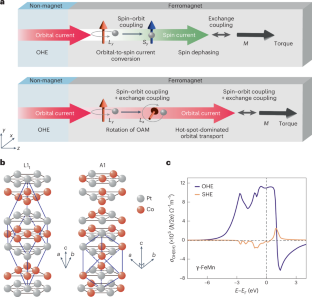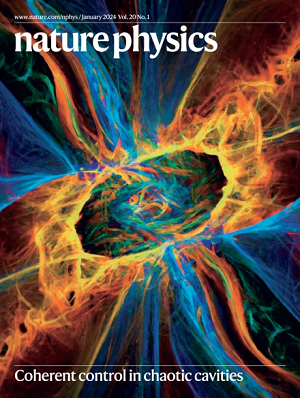Control of dynamic orbital response in ferromagnets via crystal symmetry
IF 18.4
1区 物理与天体物理
Q1 PHYSICS, MULTIDISCIPLINARY
引用次数: 0
Abstract
Transport of angular momentum is a key concept in condensed-matter physics. In solids, electrons can carry both spin and orbital angular momentum, leading to various applications in spintronics and orbitronics. A key difference between spin and orbital transport lies in their characteristic length scales in ferromagnets in which the dynamic orbital response is significantly long ranged compared with its spin counterpart. However, a comprehensive understanding of the physics behind the long-range nature of the orbital response is lacking. Here we demonstrate that the long-range dynamic orbital response in ferromagnets can be controlled by crystal symmetry. Our results manifest a clear difference in the characteristic length scale of orbital torque generation in atomically ordered and disordered CoPt alloys. This observation indicates that the long-range dynamic orbital response relies on the orbital-dependent energy splittings and hybridizations governed by crystal symmetry, which can be manipulated by atomic arrangements. Our results suggest the possibility of simultaneously controlling dynamic and static magnetic phenomena by manipulating orbital hybridization, which could be tailored for spintronic and orbitronic devices. Manipulation of the electron’s orbital contribution to transport experiments is important for potential orbitronics device applications. Now the long-range dynamic orbital response is shown to be controlled by the arrangement of atoms in ferromagnets.


通过晶体对称性控制铁磁体中的动态轨道响应
角动量的传输是凝聚态物理学中的一个关键概念。在固体中,电子既能携带自旋角动量,也能携带轨道角动量,从而在自旋电子学和轨道电子学中得到广泛应用。自旋和轨道传输的一个关键区别在于它们在铁磁体中的特征长度尺度,其中动态轨道响应与自旋响应相比具有明显的长程性。然而,人们对轨道响应长程特性背后的物理学原理还缺乏全面的了解。在这里,我们证明了铁磁体中的长程动态轨道响应可由晶体对称性控制。我们的研究结果表明,原子有序和无序 CoPt 合金中轨道力矩产生的特征长度尺度存在明显差异。这一观察结果表明,长程动态轨道响应依赖于晶体对称性所支配的轨道相关能量分裂和杂化,而晶体对称性可以通过原子排列来操纵。我们的研究结果表明,有可能通过操纵轨道杂化同时控制动态和静态磁现象,从而为自旋电子和轨道电子器件量身定制。
本文章由计算机程序翻译,如有差异,请以英文原文为准。
求助全文
约1分钟内获得全文
求助全文
来源期刊

Nature Physics
物理-物理:综合
CiteScore
30.40
自引率
2.00%
发文量
349
审稿时长
4-8 weeks
期刊介绍:
Nature Physics is dedicated to publishing top-tier original research in physics with a fair and rigorous review process. It provides high visibility and access to a broad readership, maintaining high standards in copy editing and production, ensuring rapid publication, and maintaining independence from academic societies and other vested interests.
The journal presents two main research paper formats: Letters and Articles. Alongside primary research, Nature Physics serves as a central source for valuable information within the physics community through Review Articles, News & Views, Research Highlights covering crucial developments across the physics literature, Commentaries, Book Reviews, and Correspondence.
 求助内容:
求助内容: 应助结果提醒方式:
应助结果提醒方式:


